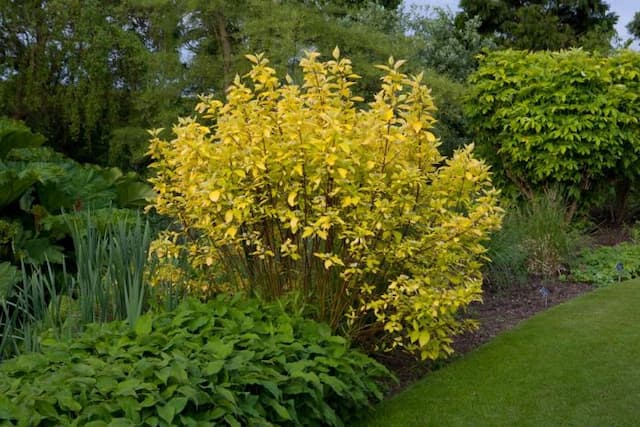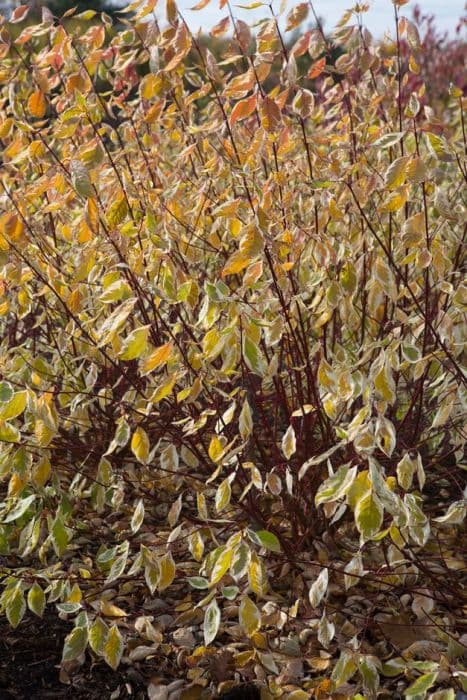Bloodgood Redtwig Dogwood Cornus alba 'Bloodgood'

ABOUT
The 'Bloodgood' is a striking ornamental plant known primarily for its vibrant and showy stems. During the colder months, when the foliage has dropped, the plant reveals its rich red or coral-colored twigs that add a pop of color to the landscape. In springtime, it greets gardeners with leaves that emerge with a burst of bright green color. As seasons change, the leaves may transform, taking on hues of variegated white and green and sometimes developing reddish-purple edges that provide a beautiful contrast against the plant's brighter elements. In addition to its notable stems and foliage, the 'Bloodgood' produces clusters of small, creamy-white flowers that bring additional interest in late spring to early summer. These flowers are quite attractive and can draw the attention of pollinators such as bees. By late summer, the flowers may give way to small, white or blue-tinted berries that are often popular with birds and other wildlife. The plant's multi-season appeal is rounded out by its fall color, which is a striking blend of pinks, reds, and purples before the leaves drop, once again showcasing the eye-catching stems that persist through the winter.
About this plant
 Names
NamesFamily
Cornaceae
Synonyms
Red-Barked Dogwood, White Dogwood, Tatarian Dogwood, Siberian Dogwood
Common names
Cornus alba 'Bloodgood'.
 Toxicity
ToxicityTo humans
Red Twig Dogwood, or Cornus alba 'Bloodgood', is generally considered to be non-toxic to humans. There are no well-documented cases of poisoning from the ingestion of this plant. However, it is always advisable to exercise caution and avoid ingesting parts of ornamental plants due to the potential for individual allergic reactions or gastric discomfort.
To pets
Red Twig Dogwood is also considered to be non-toxic to pets, such as dogs and cats. While ingestion of large quantities may cause mild gastrointestinal upset in some animals, there are no significant reports of toxicity or severe symptoms associated with the consumption of this plant by pets. Owners should still discourage their pets from eating ornamental plants as a precaution.
 Characteristics
CharacteristicsLife cycle
Perennials
Foliage type
Deciduous
Color of leaves
Green
Flower color
White
Height
6 feet (1.8 meters)
Spread
5 feet (1.5 meters)
Plant type
Shrub
Hardiness zones
2
Native area
Asia
Benefits
 General Benefits
General Benefits- Aesthetic Appeal: Cornus alba 'Bloodgood', commonly known as 'Bloodgood' dogwood, is prized for its vibrant red bark, which adds winter interest to the landscape.
- Seasonal Interest: This plant offers year-round visual interest, with white spring flowers, lush green summer foliage, and autumn leaves that turn to shades of red and purple before falling.
- Erosion Control: The dense and fibrous root system of the 'Bloodgood' dogwood helps to stabilize soil on slopes or areas prone to erosion.
- Habitat Support: It provides food in the form of berries for birds and other wildlife during the fall and winter months.
- Low Maintenance: Once established, 'Bloodgood' dogwood is relatively easy to care for, requiring minimal pruning and able to withstand some drought.
- Hardiness: This cultivar of dogwood is hardy and can thrive in a range of climatic conditions, generally in USDA zones 3-7.
- Versatility: 'Bloodgood' can be used in different landscape designs, functioning well as a specimen plant or in shrub borders, and can also be mass planted for greater impact.
- Privacy Screen: When planted in groups or rows, the dense foliage of 'Bloodgood' dogwoods provides an effective privacy screen or windbreak.
 Medical Properties
Medical PropertiesThis plant is not used for medical purposes.
 Air-purifying Qualities
Air-purifying QualitiesThis plant is not specifically known for air purifying qualities.
 Other Uses
Other Uses- Photography Backdrop: The 'Bloodgood' variety of Red Twig Dogwood has striking red stems that can add a vibrant contrast in winter photoshoots, especially against snowy backgrounds.
- Winter Garden Interest: Gardeners may plant Red Twig Dogwood for its bright red stems that provide visual interest during the otherwise drab winter months.
- Natural Dyes: The bark of the Red Twig Dogwood can be used to create natural dyes for fabrics or crafting materials, offering a range of reddish tones.
- Wildlife Shelter: Provides dense cover for birds and small animals during the winter, sometimes even used for nesting.
- Winter Crafts: Branches trimmed from the Red Twig Dogwood can be used in creating decorative wreaths or arrangements during holiday seasons.
- Edging: Used in landscape design, the plant can serve as a colorful edge for garden paths and property boundaries.
- Erosion Control: The plant can help stabilize soil on slopes or areas prone to erosion because of its root system.
- Wands for Crafts: The straight and sturdy stems are sometimes harvested for making decorative wands or sticks for craft use.
- Landscape Layering: Used in garden design, Red Twig Dogwood can provide a middle layer of vegetation between ground covers and taller shrubs or trees.
- Living Fences: When grown closely together in a line, they can form a living fence, marking property lines or creating privacy screens.
Interesting Facts
 Feng Shui
Feng ShuiThe plant known as Red Twig Dogwood can be used in Feng Shui to introduce the wood element into a space, enhance positive chi, and can be placed in the east for health or southeast for wealth and abundance as these directions are associated with wood.
 Zodiac Sign Compitability
Zodiac Sign CompitabilityThe Red Twig Dogwood is not used in astrology practice.
 Plant Symbolism
Plant Symbolism- Growth and Renewal: The Cornus alba 'Bloodgood', also known as the Red Twig Dogwood, is deciduous, shedding its leaves annually and regrowing them, symbolizing new beginnings and the cycle of growth and renewal.
- Resilience: This plant is known for its hardiness in various soil conditions and climates, representing resilience and adaptability in the face of hardship.
- Vitality: With its vibrant red stems that stand out in winter, the Red Twig Dogwood symbolizes vitality and life, particularly during the dormant winter months when color is scarce.
- Mysticism and Protection: In some cultures, dogwood trees are associated with mysticism and are believed to ward off evil spirits, offering protection.
- Contrast and Balance: The stark contrast between the bright red stems and the white snowy backdrop they're often seen against represents the balance between vibrancy and calm, action and stillness.
 Water
WaterThe Red Twig Dogwood should be watered deeply and thoroughly to ensure that the water reaches the roots. During the first growing season, it's essential to establish a good root system, so water the plant regularly, about once a week, providing about 1-1.5 inches of water each time. After establishing, water less frequently, perhaps every two weeks, unless there are prolonged dry spells. It is better to water this shrub less frequently but deeply rather than little and often. Always adjust watering based on weather conditions, with more frequent watering during hot, dry periods and less during cool, wet periods. Overwatering can cause root rot, so let the soil dry somewhat between watering.
 Light
LightRed Twig Dogwoods thrive best in full sun to partial shade. They should be positioned in a spot that receives at least four hours of direct sunlight each day but can also benefit from some shade during the hottest part of the day. An ideal placement might be in an area that gets morning sun and afternoon shade, or dappled sunlight throughout the day, to protect the leaves from scorching.
 Temperature
TemperatureRed Twig Dogwoods are hardy to a variety of temperature conditions and can survive in temperatures as low as -30°F and as high as 90°F. They grow best in temperatures between 60°F and 75°F. Extreme temperatures beyond the range of -30°F to 90°F can be harmful to the plant.
 Pruning
PruningPruning Red Twig Dogwoods is important to encourage vibrant stem color, which is most prominent on new growth. Prune one-third of the oldest stems down to the ground every year in late winter or early spring, before new growth begins. This method keeps the shrub rejuvenated, with a consistent supply of fresh stems for the best color display. Occasional thinning helps maintain an attractive shape and healthy growth.
 Cleaning
CleaningAs needed
 Soil
SoilRedtwig dogwood thrives in moist, well-drained soil rich in organic matter with a pH of 5.5 to 7.5. A mix of garden loam, peat, and sand in equal parts is ideal to ensure proper drainage and fertility for optimal growth.
 Repotting
RepottingRedtwig dogwood planted in containers may require repotting every 2-3 years to refresh the soil and provide space for root growth. However, it's typically planted outdoors where repotting isn't necessary.
 Humidity & Misting
Humidity & MistingRedtwig dogwood is adaptable to a range of humidity levels and does well in the average outdoor humidity. It does not have specific humidity requirements and can thrive in both humid and drier climates.
 Suitable locations
Suitable locationsIndoor
Provide bright light, moist soil, and cool temperatures.
Outdoor
Plant in moist soil, full sun to part shade.
Hardiness zone
2-7 USDA
 Life cycle
Life cycleCornus alba 'Bloodgood', commonly known as the Bloodgood Dogwood, begins its life as a seed, which germinates in the spring after a period of cold stratification through the winter months. After germination, the seedling grows rapidly, establishing a root system and producing its first leaves. As an immature plant, it develops into a multi-stemmed shrub, with stems turning from green to bright red as they mature, which is especially noticeable in the winter. Throughout the spring and summer, it produces flat clusters of small white flowers, followed by white to blue-tinged berries that are eaten by birds, aiding in seed dispersal. The shrub reaches maturity in several years, continuously growing wider and taller, typically up to 6-8 feet tall and wide. The life cycle is perpetuated as birds distribute the seeds, and the plant may also spread through suckering, forming colonies.
 Propogation
PropogationPropogation time
Early Spring
The Cornus alba 'Bloodgood', also known as Tatarian Dogwood, is typically propagated through hardwood cuttings. The most opportune time to collect these cuttings for propagation is during the dormant season, which is generally late fall to late winter. To do so, a gardener would select a healthy, mature stem from the shrub and cut a section of about 6 to 8 inches (15 to 20 centimeters) long. The cuttings should then be prepared by cutting just below a node, where the concentration of growth hormones is higher, which will encourage rooting. The bottom end of the cutting can be dipped in rooting hormone powder to further stimulate root development before it is planted in a pot with soil or a mixture of peat and perlite. It is then important to maintain consistent moisture and to keep the cuttings in a place with indirect light until roots have developed, after which they can be transplanted to their final location.

![Dogwood [Baton Rouge]](/_next/image?url=https%3A%2F%2Fplants-admin.emdemapps.com%2Fimages%2Fplants%2F%2Fimages%2F604b59cf0fefd.png&w=640&q=75)

![Dogwood [Ivory Halo]](/_next/image?url=https%3A%2F%2Fplants-admin.emdemapps.com%2Fimages%2Fplants%2F%2Fimages%2F604b535cbcb9a.png&w=640&q=75)





![Dogwood [Venus]](/_next/image?url=https%3A%2F%2Fplants-admin.emdemapps.com%2Fimages%2Fplants%2F%2Fimages%2F604b58a531da1.png&w=640&q=75)